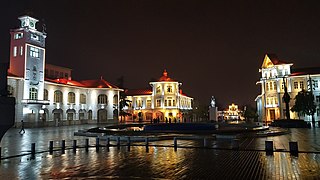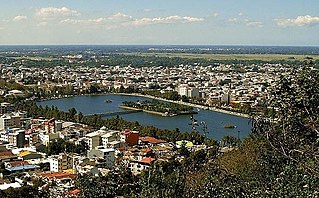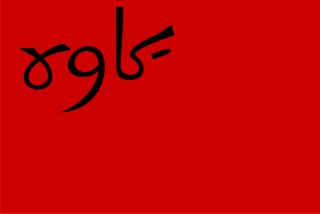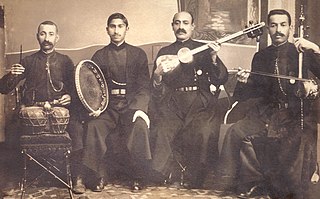
Nowruz is the Iranian New Year, also known as the Persian New Year, which is celebrated worldwide by various ethno-linguistic groups.

Gilan Province, is one of the 31 provinces of Iran. It lies along the Caspian Sea, in Iran's Region 3, west of the province of Mazandaran, east of the province of Ardabil, and north of the provinces of Zanjan and Qazvin. It borders the Republic of Azerbaijan in the north and Russia across the Caspian Sea.

Rasht is the capital city of Gilan Province, Iran. Also known as the "City of Rain", it had a population of 639,951 as of the 24 October 2011 census and is the most densely populated city of Iran.

Lahijan is a city near the Caspian sea and the capital of Lahijan County, Gilan Province, Iran. At the 2016 census, its population was 167,544 in 58,378 families.

The Persian Socialist Soviet Republic, also known as the Soviet Republic of Gilan was a short-lived unrecognized state, a Soviet republic in the Iranian province of Gilan that lasted from June 1920 until September 1921. It was established by Mirza Koochak Khan, a leader of the Constitutionalist movement of Gilan, and his Jangali partisans, with the assistance of the Soviet Union's Red Army.

Naz Nomad and The Nightmares was a one-off project featuring the members of British punk and gothic rock band the Damned.
Pashtun culture is based on Pashtunwali, which is an ancient way of life, as well as speaking of the Pashto language and wearing Pashtun dress. The culture of the Pashtun people is highlighted since at least the time of Herodotus or Alexander the Great, when he explored the Afghanistan and Pakistan region in 330 BC. The Pashtun culture has had little outside influence over the ages.

There are a number of Azerbaijani dances used by the Azerbaijani people of Azerbaijan and Iranian Azerbaijan. Azerbaijan's national dance shows the characteristics of the Azerbaijani nation. These dances differ from other dances with its quick temp. And this talks about nation's quickness. The national clothes of Azerbaijan are well preserved within the national dances.

Sizdah Bedar, also known as Nature's Day, is an Iranian festival held annually on the thirteenth day of Farvardin, the first month of the Iranian calendar, during which people spend time picnicking outdoors. It marks the end of the Nowruz holidays in Iran.
Iranian folklore encompasses the folk traditions that have evolved in Iran.

Kivi is a city in and the capital of Kowsar County, Ardabil Province, Iran. At the 2006 census, its population was 6,467, in 1,721 families. Earlier, Kivi was divided into upper and lower Kivi: düz kıvı and aşaği kıvı.

Novruz in Azerbaijan is a traditional holiday which celebrates the New Year and the coming of Spring. When Azerbaijan was part of the Soviet Union, celebration of Novruz was generally unofficial and at times even prohibited. Currently in Azerbaijan, Novruz is treated as an official public holiday. In accordance with Article 105 of the Labour Code of Azerbaijan passed in 2006, workers receive five days off for Novruz. After neighbouring Iran, Azerbaijan hosts the longest observance and number of public days related to Novruz, with a total of 5 days.

Nazarlu is a village in Mishu-e Jonubi Rural District, Sufian District, Shabestar County, East Azerbaijan Province, Iran. At the 2006 census, its population was 4,984, in 1,169 families.

Amu Nowruz, also known as Baba Nowruz, is a fictional figure in Iranian folklore. According to the folklore, he appears annually at the beginning of spring, together with his companion Haji Firuz, to mark the beginning of Nowruz, the Iranian New Year. According to some historians he symbolizes Zal, father of Rostam, the hero of Shahnameh.

Shadegan is a village in Kuh Mareh Khami Rural District, in the Central District of Basht County, Kohgiluyeh and Boyer-Ahmad Province, Iran. At the 2006 census, its population was 26, in 8 families.
Zarrinnaal or Zarrin Naal is the name of a dynasty of Persian-Kurdish tribal chiefs and state officials belonging to the Zarrin Kafsh tribe and originated from Sanandaj in Kurdistan Province of Iran. Their heads with the title of Beyg, Beyk or Beg (lit."lord") were the Aghas of Senneh and ruled their fiefdom during the time of four hundred years when the Safavids, Afsharids and finally Qajar dynasty reigned in Iran.

Nazareth Jersey Mitrou-Long is a Canadian-Greek professional basketball player for the Indiana Pacers of the National Basketball Association (NBA), on a two-way contract with the Fort Wayne Mad Ants of the NBA G League. He played college basketball for the Iowa State Cyclones. Born in Mississauga, Ontario, he played high school basketball at Father Michael Goetz in his hometown. In 2012, he started playing college basketball for Iowa State. He played in the 2017 NBA Summer League for the Sacramento Kings.

Taj Al-Duleh was the forty second wife of Fath-Ali Shah Qajar and a poet. Her birth name was Tavus Khanum and she was from Georgian descent. She was born in Isfahan. She married Fath-Ali Shah in 1845 when she was 15 years old. The King changed the name of bejeweled Khorshid throne to Tavus throne on the occasion of this marriage. She was educated under the supervisor of Neshat Isfahani. After a while the King ordered to build a mansion for her because of his passionate love. Also a part of royal treasury was entrusted to her which was called the special treasury. Every Nowruz she used to invite the King along with his wives and married daughters to her mansion for thirteen days.

Kudi Chin or Kadi Chin, also spelled "Kudee Jeen", etc. is a historic neighbourhood in Bangkok. It is in Wat Kanlaya Sub-district, Thon Buri District, on the west bank of the Chao Phraya River, south of Bangkok Yai Canal. The neighbourhood, dating to the Ayutthaya period, includes communities of several faiths living in close proximity. Today, it is best known for the Catholic community around Santa Cruz Church, but the wider neighbourhood also includes the areas around Wat Kanlayanamit, Kudi Khao Mosque, and the Chinese Kuan An Keng Shrine. Conservation and revitalization efforts beginning in 2008 have made the neighbourhood a cultural tourism destination.














